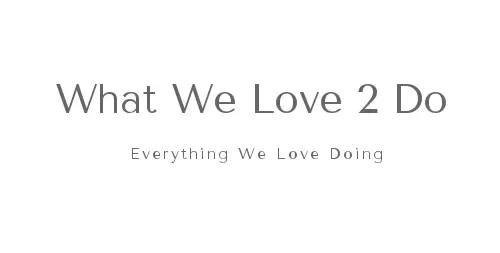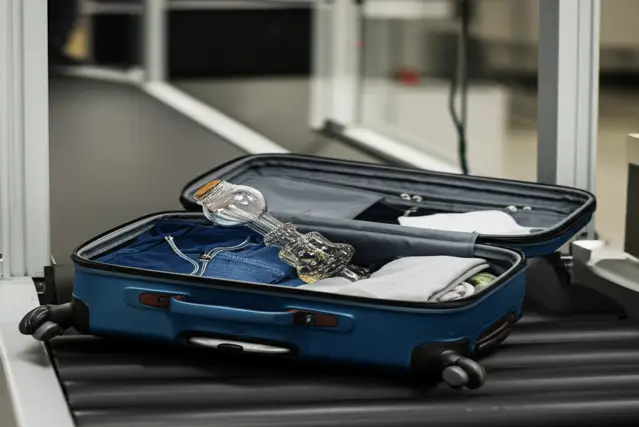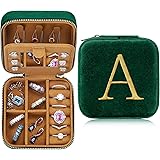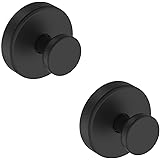Planning a trip and wondering if your trusty bong can come along for the ride? Navigating the world of air travel with smoking paraphernalia can be tricky, especially with evolving regulations and varying state laws. This comprehensive guide will break down everything you need to know about flying with a bong in 2024.
We’ll cover TSA regulations, legal considerations, cleaning tips, and practical advice to help you make informed decisions and avoid any potential legal headaches. Buckle up, and let’s get started!
Table of Contents
The Murky Waters of Travel and Paraphernalia
The legal landscape surrounding cannabis and related accessories is constantly shifting. While some states have fully legalized recreational marijuana, others maintain strict prohibitions. This patchwork of laws creates confusion, especially when you factor in federal regulations governing air travel. Bringing a bong on a plane is a question that requires careful consideration, as the answer isn’t always straightforward. It depends on a variety of factors, including the origin and destination of your flight, the condition of the bong, and the interpretation of TSA agents.
This guide aims to provide clarity amidst this complexity. We’ll delve into the nuances of TSA regulations, examine potential legal ramifications, and offer practical tips to help you navigate this tricky situation responsibly. Our goal is to empower you with the knowledge you need to make informed choices and avoid any unnecessary legal troubles during your travels. Remember, ignorance of the law is never an excuse, so understanding the rules is crucial.
Understanding TSA Regulations: What They Say (and Don’t Say) About Bongs
The Transportation Security Administration (TSA) is responsible for ensuring the safety and security of travelers and the nation’s transportation systems. While the TSA’s primary focus is on preventing terrorism and other security threats, their agents also come across a wide range of items, including smoking paraphernalia. It’s important to understand how the TSA views bongs and similar items.
TSA’s Stance on Drug Paraphernalia: A Gray Area
The TSA’s official policy is that they are not actively searching for marijuana or other illegal drugs. Their focus is on security threats like weapons and explosives. However, if a TSA agent discovers what appears to be drug paraphernalia during a security screening, they are required to report it to local law enforcement.
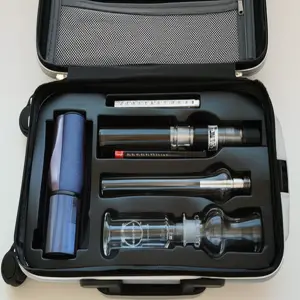
travel paraphernalia
This is where the gray area comes in. The TSA’s website states that items that are illegal under federal law are prohibited. While marijuana remains illegal at the federal level, the legality of paraphernalia, like bongs, is often determined by state and local laws. Therefore, the TSA’s response to a bong depends largely on the laws of the state where the airport is located. If the state has legalized recreational marijuana and the bong shows no signs of containing marijuana residue, the TSA agent may be more likely to allow it. However, if the state has strict anti-drug laws or the bong appears to have been used, the agent is more likely to report it to local law enforcement.
It’s crucial to understand that TSA agents are not law enforcement officers. They are security personnel tasked with enforcing federal transportation regulations. However, they are obligated to report suspected illegal activity to the appropriate authorities. This means that even if the TSA agent doesn’t personally care about your bong, they may be required to involve local police, who could then take further action.
Read About: Can Uber Eats Deliver To Hotel Rooms? Find Out Now!
TSA Guidelines and Real-World Scenarios
Let’s look at some real-world scenarios to illustrate how the TSA might handle a bong:
- Scenario 1: You’re flying from Denver (where recreational marijuana is legal) to Los Angeles (where recreational marijuana is also legal) with a brand-new, unused bong in your checked luggage. In this scenario, the TSA agent is unlikely to flag the bong, as it doesn’t pose a security threat and is legal in both the origin and destination states.
- Scenario 2: You’re flying from Atlanta (where recreational marijuana is illegal) to Seattle (where recreational marijuana is legal) with a used bong containing marijuana residue in your carry-on luggage. In this scenario, the TSA agent is highly likely to report the bong to local law enforcement in Atlanta, as it’s considered drug paraphernalia and contains illegal residue. You could face legal consequences, even if your destination is a state where marijuana is legal.
- Scenario 3: You’re flying from Chicago (where recreational marijuana is legal) to Miami (where medical marijuana is legal, but recreational use is not) with a thoroughly cleaned bong in your checked luggage. In this scenario, the outcome is less certain. While the bong itself might not be illegal in Chicago, possessing drug paraphernalia could still be a misdemeanor in Florida. The TSA agent’s decision might depend on their personal interpretation of the law and the specific circumstances.
These scenarios highlight the importance of understanding the laws of both your origin and destination states. It’s also crucial to ensure that your bong is thoroughly cleaned and shows no signs of containing marijuana residue. Even in states where marijuana is legal, the presence of residue can be considered evidence of illegal drug use, leading to potential legal trouble.
Checked vs. Carry-On Luggage: Does It Make a Difference?
The TSA’s regulations apply to both checked and carry-on luggage. However, there are some practical differences to consider. Carry-on luggage is subject to more scrutiny during the security screening process. TSA agents are more likely to examine carry-on items closely, increasing the chances of discovering a bong. On the other hand, checked luggage is often screened less thoroughly, but if a suspicious item is detected, the TSA has the right to open and inspect your bag.
Many people assume that it’s safer to pack a bong in checked luggage, hoping it will go unnoticed. While this strategy might work in some cases, it’s not a guarantee. If the TSA finds a bong in your checked luggage and it’s considered illegal, you could still face legal consequences. It’s generally advisable to err on the side of caution and follow the same rules for both checked and carry-on luggage: ensure that the bong is thoroughly cleaned, legal in both your origin and destination states, and packed discreetly.
Legal Considerations: State vs. Federal Laws and Potential Penalties
Navigating the legal landscape surrounding cannabis and paraphernalia requires a thorough understanding of both state and federal laws. While the TSA’s primary concern is security, local law enforcement is responsible for enforcing drug laws. This means that even if the TSA allows you to bring a bong on a plane, you could still face legal penalties if it violates state or local laws.
State-Specific Laws on Drug Paraphernalia
The legality of drug paraphernalia, including bongs, varies widely from state to state. In states where recreational marijuana is legal, the possession of paraphernalia is generally legal as well, provided that it’s used for consuming legally obtained marijuana. However, even in these states, there might be restrictions on the type of paraphernalia that is allowed or the age of the person possessing it.
In states where marijuana is illegal, the possession of drug paraphernalia is typically a misdemeanor offense, punishable by fines, jail time, or both. The severity of the penalties can vary depending on the state and the specific circumstances of the case. For example, possessing a small bong with minimal residue might result in a minor fine, while possessing a large bong with significant residue could lead to a more serious charge.
It’s crucial to research the drug paraphernalia laws of both your origin and destination states before traveling with a bong. You can find this information on state government websites or by consulting with a lawyer who specializes in drug laws. Remember, ignorance of the law is not a valid defense, so it’s your responsibility to ensure that you’re complying with all applicable regulations.
Here’s a table summarizing the general legal status of marijuana and paraphernalia in different types of states (this is a generalization and specific laws vary):
| State Type | Marijuana Legal Status | Paraphernalia Legal Status (General) | Considerations |
|---|---|---|---|
| Recreational Legal States | Legal for recreational and medical use | Generally legal, with possible restrictions on age or type of paraphernalia | Ensure paraphernalia is used for legally obtained marijuana and comply with age restrictions. |
| Medical Legal States | Legal for medical use only | Legal for registered medical marijuana patients, often with restrictions. | Requires valid medical marijuana card and compliance with state regulations. |
| Decriminalized States | Possession of small amounts is decriminalized | Often still illegal, although enforcement may be lax. | Possession of paraphernalia can still result in fines or other penalties. |
| Illegal States | Marijuana is illegal | Paraphernalia is also illegal. | Possession can result in fines, jail time, and a criminal record. |
Federal Law and the Supremacy Clause
While state laws play a significant role in determining the legality of drug paraphernalia, federal law also has a bearing on the issue. Under the Supremacy Clause of the U.S. Constitution, federal laws are supreme to state laws. This means that if there’s a conflict between a state law and a federal law, the federal law prevails.
Marijuana remains illegal at the federal level, classified as a Schedule I controlled substance under the Controlled Substances Act. This means that the federal government can prosecute individuals for marijuana-related offenses, even if they’re complying with state laws. However, the federal government has generally taken a hands-off approach to marijuana enforcement in states where it’s legal, focusing instead on cases that involve interstate trafficking or other federal crimes.
Despite this hands-off approach, the federal government still has the authority to enforce federal marijuana laws, including laws related to drug paraphernalia. This means that even if you’re flying between two states where marijuana is legal, you could theoretically face federal charges for possessing a bong, especially if it’s considered to be involved in interstate commerce.
In practice, the risk of federal prosecution for possessing a bong is relatively low, especially if you’re not involved in any other illegal activity. However, it’s important to be aware of the potential risks and to exercise caution when traveling with drug paraphernalia. Consulting with a lawyer familiar with federal drug laws can provide you with a more accurate assessment of your specific risk factors.
Potential Penalties for Traveling with a Bong
The potential penalties for traveling with a bong depend on a variety of factors, including the state laws, the presence of marijuana residue, and your prior criminal record. In general, the penalties for possessing drug paraphernalia range from minor fines to jail time. In some cases, you could also face asset forfeiture, meaning that the government could seize your bong and other property associated with the offense.
Here are some potential penalties you could face for traveling with a bong:
- Fines: Fines for possessing drug paraphernalia can range from a few hundred dollars to several thousand dollars, depending on the state and the severity of the offense.
- Jail time: Jail time for possessing drug paraphernalia can range from a few days to several months, depending on the state and your prior criminal record. In some cases, you could face a year or more in jail.
- Criminal record: A conviction for possessing drug paraphernalia can result in a criminal record, which can make it difficult to find employment, housing, or educational opportunities.
- Asset forfeiture: In some states, the government can seize your bong and other property associated with the offense, such as your car or your money.
It’s important to understand that these are just potential penalties. The actual penalties you face will depend on the specific circumstances of your case. If you’re arrested for possessing a bong, it’s crucial to consult with a lawyer as soon as possible to understand your rights and options.
Cleaning Your Bong: Minimizing Risk and Avoiding Residue Issues
One of the most important steps you can take to minimize the risk of legal trouble when traveling with a bong is to ensure that it’s thoroughly cleaned. The presence of marijuana residue can significantly increase the likelihood of facing legal penalties, even in states where marijuana is legal. Cleaning your bong effectively removes any evidence of illegal drug use and reduces the chances of attracting unwanted attention from TSA agents or law enforcement.
Best Practices for Cleaning a Bong Before Travel
Here are some best practices for cleaning a bong before travel:
- Disassemble the bong: Remove all detachable parts, such as the bowl, downstem, and any other accessories.
- Rinse with hot water: Rinse all parts of the bong with hot water to remove any loose debris.
- Use a cleaning solution: There are several commercially available cleaning solutions specifically designed for bongs. These solutions typically contain isopropyl alcohol and a salt abrasive. You can also make your own cleaning solution by mixing isopropyl alcohol (91% or higher) with coarse salt, such as Epsom salt or sea salt.
- Soak the parts: Soak all parts of the bong in the cleaning solution for at least 30 minutes. For heavily soiled bongs, you may need to soak the parts overnight.
- Scrub the parts: Use a brush or pipe cleaner to scrub the inside of the bong and its parts. Pay particular attention to areas where residue tends to accumulate, such as the bowl, downstem, and the bottom of the bong.
- Rinse thoroughly: Rinse all parts of the bong thoroughly with hot water to remove all traces of the cleaning solution.
- Dry completely: Allow all parts of the bong to dry completely before packing them for travel. This will prevent the growth of mold and mildew.
By following these steps, you can effectively clean your bong and minimize the risk of facing legal penalties for possessing drug paraphernalia with marijuana residue. *_Consider using a specialized cleaning kit_* for more efficient cleaning.
DIY Cleaning Solutions and Techniques
If you don’t have access to commercially available cleaning solutions, you can make your own using common household items. Here are some DIY cleaning solutions and techniques:
- Isopropyl alcohol and salt: This is the most common and effective DIY cleaning solution. Mix isopropyl alcohol (91% or higher) with coarse salt, such as Epsom salt or sea salt. The alcohol dissolves the residue, while the salt acts as an abrasive to scrub it away.
- Vinegar and baking soda: This is a gentler cleaning solution that can be used on more delicate bongs. Mix vinegar and baking soda to create a foaming solution. Let the solution sit in the bong for a few minutes, then scrub it with a brush.
- Lemon juice and salt: This is another natural cleaning solution that can be used to remove stains and odors. Mix lemon juice with salt to create a paste. Apply the paste to the stained areas of the bong and let it sit for a few minutes, then scrub it with a brush.
When using DIY cleaning solutions, it’s important to test them on a small, inconspicuous area of the bong first to ensure that they don’t damage the material. It’s also important to rinse the bong thoroughly with hot water after using any cleaning solution to remove all traces of the cleaner.
Inspecting for Residue: A Critical Step
After cleaning your bong, it’s crucial to inspect it carefully for any remaining residue. Even a small amount of residue can be enough to attract unwanted attention from TSA agents or law enforcement. Use a flashlight to examine the inside of the bong and its parts closely. Pay particular attention to areas where residue tends to accumulate, such as the bowl, downstem, and the bottom of the bong.
If you find any residue, repeat the cleaning process until it’s completely removed. You may need to soak the parts in cleaning solution for a longer period of time or use a more abrasive cleaning tool to remove stubborn residue. Once you’re satisfied that the bong is completely clean, dry it thoroughly and pack it carefully for travel.
Packing Your Bong for Travel: Discretion and Protection
How you pack your bong for travel can make a significant difference in whether or not you encounter problems with the TSA or law enforcement. Discretion and protection are key. You want to pack your bong in a way that minimizes the chances of it being discovered and protects it from damage during transit.
Choosing the Right Container: Cases, Bags, and Padding
The first step in packing your bong is to choose the right container. Here are some options to consider:
- Hard-sided case: A hard-sided case provides the best protection for your bong. Look for a case that is specifically designed for transporting delicate items, such as musical instruments or camera equipment. These cases typically have foam padding that can be customized to fit your bong perfectly.
- Soft-sided bag: A soft-sided bag is a more discreet option than a hard-sided case. Look for a bag that is made from durable material and has plenty of padding to protect your bong. You can also add extra padding by wrapping your bong in bubble wrap or towels.
- Original packaging: If you still have the original packaging that your bong came in, this is often the best option for transporting it. The original packaging is typically designed to protect the bong from damage during shipping.
When choosing a container, consider the size and shape of your bong, as well as the level of protection you need. If you’re traveling with a large, delicate bong, a hard-sided case is probably the best option. If you’re traveling with a smaller, more durable bong, a soft-sided bag might be sufficient.
Discreet Packing Techniques: Avoiding Unnecessary Attention
In addition to choosing the right container, it’s important to pack your bong in a discreet manner. Here are some tips for avoiding unnecessary attention:
- Wrap the bong in bubble wrap or towels: This will protect the bong from damage and also help to conceal its shape.
- Place the bong in the center of your luggage: Surround the bong with other items of clothing or personal belongings to further conceal it.
- Avoid packing the bong with marijuana or other drug-related items: This will only increase the chances of encountering problems with the TSA or law enforcement.
- Do not declare the bong to TSA: Be honest if asked directly but volunteering information can lead to more scrutiny.
The goal is to make it as difficult as possible for anyone to identify the item as a bong without opening the container. The more discreetly you pack your bong, the less likely you are to attract unwanted attention.
Protecting Fragile Parts: Bowls, Downstems, and Accessories
Bongs often have fragile parts, such as bowls, downstems, and other accessories, that can easily break during transit. It’s important to protect these parts carefully to prevent damage. Here are some tips for protecting fragile parts:
- Remove the fragile parts from the bong: This will prevent them from breaking if the bong is jostled during transit.
- Wrap the fragile parts in bubble wrap or foam padding: This will protect them from impacts and vibrations.
- Place the fragile parts in a separate container: This will prevent them from damaging the bong or other items in your luggage. A small, hard-sided case or a padded pouch is a good option.
By taking these precautions, you can protect the fragile parts of your bong and prevent them from breaking during travel. Consider purchasing specialized protective cases for delicate parts.
Navigating Airport Security: What to Expect and How to Respond
Going through airport security with a bong can be a nerve-wracking experience. Knowing what to expect and how to respond to questions from TSA agents can help you navigate the process smoothly and avoid any unnecessary problems.
Approaching the Security Checkpoint: Demeanor and Attitude
Your demeanor and attitude can play a significant role in how TSA agents perceive you. It’s important to approach the security checkpoint with a calm and respectful attitude. Avoid being overly nervous or defensive, as this can raise suspicion. Be polite and cooperative with the TSA agents, and follow their instructions carefully.
Remember, TSA agents are trained to detect suspicious behavior. If you appear nervous or evasive, they may be more likely to scrutinize your luggage and ask you more questions. By maintaining a calm and respectful attitude, you can help to defuse the situation and avoid any unnecessary problems.
Answering Questions: Honesty vs. Self-Incrimination
If a TSA agent asks you about the contents of your luggage, it’s important to answer honestly, but also to avoid self-incrimination. You have the right to remain silent and the right to an attorney. If you’re unsure how to answer a question, it’s best to politely decline to answer and request to speak with an attorney. Do not lie to a federal officer; that is a crime.
For example, if a TSA agent asks you, “What’s in this bag?” you could respond, “It contains personal belongings.” If the TSA agent then asks, “Is there anything illegal in the bag?” you could politely decline to answer and request to speak with an attorney. *_Knowing your rights is crucial_* in such situations.
It’s important to understand that the TSA agent’s goal is to determine whether you pose a security threat. They are not necessarily trying to catch you with drug paraphernalia. However, if they discover a bong in your luggage, they may be required to report it to local law enforcement. Therefore, it’s important to be cautious and avoid providing any information that could incriminate you.
If Your Bong Is Discovered: Rights and Options
If a TSA agent discovers your bong, it’s important to remain calm and assert your rights. Here are some steps you can take:
- Remain calm and respectful: Avoid arguing with the TSA agent or becoming defensive.
- Ask for clarification: Ask the TSA agent why they are questioning you about the bong.
- Assert your right to remain silent: You have the right to refuse to answer any questions.
- Request to speak with an attorney: You have the right to consult with an attorney before answering any questions.
- Do not consent to a search: If the TSA agent asks to search your luggage, you have the right to refuse. However, the TSA agent may be able to obtain a warrant to search your luggage without your consent.
If the TSA agent decides to confiscate your bong, ask for a receipt. The receipt should include a description of the bong and the reason for its confiscation. You may be able to challenge the confiscation in court. If local law enforcement becomes involved, it’s essential to contact an attorney immediately. An attorney can advise you of your rights and help you navigate the legal process.
Alternative Options: Shipping Your Bong or Buying One at Your Destination
If you’re concerned about the risks of flying with a bong, there are alternative options to consider. Shipping your bong to your destination or buying one upon arrival can be a safer and more convenient way to avoid any potential legal problems.
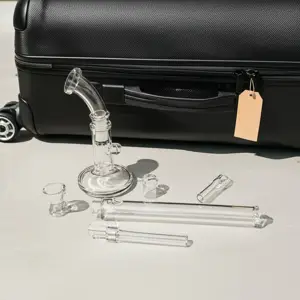
smoking device
Shipping Your Bong: Considerations and Best Practices
Shipping your bong can be a convenient way to transport it without having to worry about TSA regulations or airport security. However, there are some considerations to keep in mind:
- Legality: Ensure that it’s legal to ship drug paraphernalia to your destination state. Some states have laws that prohibit the shipment of drug paraphernalia.
- Packaging: Pack your bong carefully to protect it from damage during shipping. Use a sturdy box and plenty of padding, such as bubble wrap or packing peanuts.
- Shipping company: Choose a reputable shipping company that offers tracking and insurance. This will protect you in case the package is lost or damaged.
- Disclosure: Be careful about what you disclose to the shipping company. While you don’t necessarily need to tell them that you’re shipping a bong, you should be honest if they ask you directly.
It’s important to note that shipping drug paraphernalia through the U.S. Postal Service (USPS) is illegal under federal law. However, private shipping companies, such as UPS and FedEx, may allow you to ship drug paraphernalia as long as it’s legal in both the origin and destination states. Always verify the shipping company’s policy before sending your package.
Buying a Bong at Your Destination: Convenience vs. Availability
Another option is to simply buy a bong at your destination. This eliminates the risk of transporting a bong and avoids any potential legal problems. However, there are some drawbacks to consider:
- Availability: Depending on your destination, it may not be easy to find a bong. In states where marijuana is illegal, head shops may be scarce or non-existent.
- Price: Bongs can be more expensive at your destination than they are at home. This is especially true if you’re buying from a head shop in a tourist area.
- Quality: The quality of bongs can vary widely. You may not be able to find a bong that meets your standards at your destination.
If you decide to buy a bong at your destination, research the availability of head shops and the prices of bongs in advance. You can also ask locals for recommendations on where to buy a good quality bong.
The Future of Cannabis and Travel: Trends and Predictions
The legal landscape surrounding cannabis and travel is constantly evolving. As more states legalize marijuana, it’s likely that regulations surrounding the transportation of paraphernalia will become more relaxed. However, there are also some potential challenges on the horizon, such as increased federal scrutiny and stricter enforcement of existing laws.
Potential Changes in TSA Regulations
As marijuana becomes more widely accepted, it’s possible that the TSA will eventually change its regulations regarding the transportation of paraphernalia. The TSA could adopt a more lenient approach, focusing on security threats rather than drug-related items. However, this is not guaranteed. The TSA’s regulations are ultimately determined by the federal government, which could take a more conservative approach to marijuana enforcement.
Read About: Can You Take a Pack and play on a Plane?
One possible scenario is that the TSA will create a separate category for marijuana-related items, similar to the way it handles medications. This would allow travelers to transport small amounts of marijuana and paraphernalia, provided that they comply with certain restrictions, such as obtaining a doctor’s recommendation or registering with a state-regulated program.
The Impact of Federal Legalization
If marijuana is legalized at the federal level, it would likely have a significant impact on travel regulations. Federal legalization would eliminate the conflict between state and federal laws, making it easier for travelers to transport marijuana and paraphernalia between states. However, federal legalization could also lead to increased regulation of the cannabis industry, which could affect the availability and price of marijuana and paraphernalia.
For example, the federal government could impose taxes on marijuana and paraphernalia, which would increase the cost to consumers. The federal government could also regulate the production, distribution, and sale of marijuana and paraphernalia, which could limit the types of products that are available. Staying informed about legislative changes is essential for travelers.
The Rise of Cannabis Tourism
As more states legalize marijuana, cannabis tourism is becoming increasingly popular. Cannabis tourism involves traveling to states where marijuana is legal to consume and purchase cannabis products. This trend is expected to continue to grow in the coming years, as more people become interested in experiencing the benefits of legal marijuana.
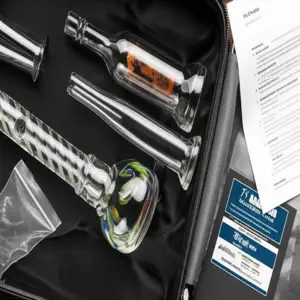
prohibited items
The rise of cannabis tourism could lead to changes in travel regulations, as states compete to attract cannabis tourists. States could adopt more lenient regulations regarding the transportation of marijuana and paraphernalia, in order to make it easier for tourists to bring their own supplies. States could also develop cannabis-friendly hotels and resorts, which would allow tourists to consume marijuana on-site.
FAQ: Frequently Asked Questions About Flying with a Bong
Is it legal to fly with a bong in the United States?
The legality of flying with a bong depends on various factors, including the laws of your origin and destination states, whether the bong is clean, and the interpretation of TSA agents. Generally, it’s legal to fly with a clean, unused bong in states where marijuana is legal. However, it’s illegal to fly with a bong containing marijuana residue or in states where marijuana is prohibited.
What does the TSA say about bongs?
The TSA’s primary focus is on security threats, not drug enforcement. However, if a TSA agent discovers what appears to be drug paraphernalia, they are required to report it to local law enforcement. The TSA’s website states that items that are illegal under federal law are prohibited. Marijuana remains illegal at the federal level, so the TSA’s response to a bong depends largely on state and local laws.
Can I bring a bong in my checked luggage?
You can attempt to bring a bong in your checked luggage, but it’s not a guarantee that it will go unnoticed. The TSA has the right to open and inspect your checked luggage. If they find a bong and it’s considered illegal, you could face legal consequences. It’s generally advisable to follow the same rules for both checked and carry-on luggage: ensure that the bong is thoroughly cleaned, legal in both your origin and destination states, and packed discreetly.
What should I do if the TSA finds my bong?
If the TSA finds your bong, remain calm and assert your rights. Ask for clarification, assert your right to remain silent, and request to speak with an attorney. Do not consent to a search unless required by law. If the TSA confiscates your bong, ask for a receipt. If local law enforcement becomes involved, contact an attorney immediately.
How can I clean my bong effectively before traveling?
To clean your bong effectively, disassemble it, rinse it with hot water, use a cleaning solution (such as isopropyl alcohol and salt), soak the parts for at least 30 minutes, scrub the parts with a brush, rinse thoroughly, and dry completely. Inspect the bong carefully for any remaining residue before packing it.
What are some alternative options to flying with a bong?
Alternative options include shipping your bong to your destination via a private shipping company (ensure it’s legal in both states), or buying a new bong upon arrival at your destination.
Is it safer to ship my bong than to fly with it?
Shipping your bong can be a safer option than flying with it, as it avoids the scrutiny of airport security. However, it’s important to ensure that it’s legal to ship drug paraphernalia to your destination state and to pack the bong carefully to protect it from damage.
What are the potential penalties for traveling with a bong?
The potential penalties for traveling with a bong depend on the state laws, the presence of marijuana residue, and your prior criminal record. Penalties can range from minor fines to jail time, asset forfeiture, and a criminal record.
How do state and federal laws interact regarding drug paraphernalia?
Under the Supremacy Clause of the U.S. Constitution, federal laws are supreme to state laws. While marijuana remains illegal at the federal level, the federal government has generally taken a hands-off approach to marijuana enforcement in states where it’s legal. However, the federal government still has the authority to enforce federal marijuana laws, including laws related to drug paraphernalia.
Will regulations change in the future regarding cannabis and travel?
As more states legalize marijuana, it’s likely that regulations surrounding the transportation of paraphernalia will become more relaxed. The TSA could adopt a more lenient approach, and federal legalization could eliminate the conflict between state and federal laws. However, there are also potential challenges on the horizon, such as increased federal scrutiny and stricter enforcement of existing laws. Keep an eye on legal updates for future travel.
Conclusion: Final Thoughts on Flying with a Bong in 2024
Navigating the legal complexities of traveling with a bong in 2024 requires careful consideration, thorough research, and a willingness to err on the side of caution. While the allure of having your favorite piece readily available at your destination is understandable, the potential legal ramifications and hassle of dealing with TSA or law enforcement can quickly overshadow the convenience. Remember, the key lies in understanding the laws of both your origin and destination states, ensuring your bong is meticulously cleaned, and packing it discreetly, if you choose to travel with it at all. Always prioritize minimizing risk and avoiding unnecessary attention.
The information presented in this guide should empower you to make informed decisions, but it’s not a substitute for legal advice. Laws are constantly evolving, and individual circumstances can vary significantly. When in doubt, consult with an attorney who specializes in drug laws to get personalized guidance based on your specific situation. It’s always better to be overprepared than to face unexpected legal consequences during your travels. Whether you choose to leave your bong at home, ship it ahead, or purchase one upon arrival, prioritizing legality and safety should always be your guiding principles. As cannabis legalization continues to spread across the country, it’s likely that travel regulations will evolve as well. Staying informed and adapting to these changes will be crucial for responsible travelers in the years to come. So, pack smart, travel safe, and enjoy your journey responsibly!
